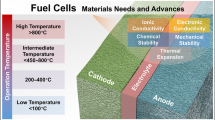The mechanism of the action of oxygenates is discussed from the standpoint of redox reactions. It is shown that the action of oxygenates on the process of combustion of hydrocarbons is associated with oxidation of the latter in steps. The reason for the increase in octane number upon addition of oxygenates may be different rate of overcoming conformational differences under conditions close to the critical temperature of the hydrocarbon at the pre-ignition combustion stage. The influence of propylene oxide on the performance properties of gasoline is examined.
Similar content being viewed by others
References
A. M. Danilov, Use of Additives in Fuels [in Russian], Mir, Moscow (2005), p. 288.
P. V. Chulkov, Motor Fuels: Resources, Quality, and Substituents—A Handbook [in Russian], Politekhnika, Moscow (1998), p. 416.
G. A. Teren’tev, V. M. Tyukov, and F. V. Smal’, Motor Fuels from Alternative Sources [in Russian], Khimiya, Moscow (1989), p. 272.
G. F. Bol’shakov, Physicochemical Principles of Use of Fuels and Oils. Theoretical Principles of Chemmotology [in Russian], Nauka, Novosibirsk (1987), p. 208.
D. V. Tsygankov, S. A. Vasyanina, and A. M. Miroshnikov, in: Collec. Sci. Papers of the Kemarovo Technol. Inst. Food Ind. “Food Products and Efficient Use of Raw Material Resources,” No. 12, 135-136 (2007).
J. March, Organic Chemistry: Reaction, Mechanisms, and Structure, Vol. 4 [Russian translation from English], Mir, Moscow (1988), p. 468.
M. S. Malikovskii, Olefin Oxides and Their Production [in Russian], Goskhimizdat, Moscow (1961), p. 554.
P. V. Zimakov and O. N. Dyment (editors), Ethylene Oxide [in Russian], Khimiya, Moscow (1967), p. 320.
S. V. Kudryashov, G. S. Shcheglov, E. E. Sirotkina, et al., in: Papers at the 4th Intl. Conf. “Chemistry of Oil and Gas,” Vol. 2 [in Russian], Tomsk (2002), pp. 272-275.
M. Sitting, Processes of Oxidation of Hydrocarbons [Russian translation from English], Khimiya, Moscow (1970), p. 300.
US Patent 3106582.
V. S. Timofeev and L. A. Serafimov, Principles of the Technology of Organic and Petrochemical Synthesis [in Russian], 2nd revised edition, Vysshaya Shkola, Moscow (2003), p. 536.
G. Nikolis and I. Prigozhin, Cognition of the Complex [in Russian], Mir, Moscow (1990), p. 344.
D. V. Tsygankov, Candidate’s Dissertation [in Russian], Kuzbass State Technical University, Kemerovo (2006).
Inventor’s Certificate 44137A, Bulgaria.
D. V. Tsygankov, A. M. Miroshnikov, and A. M. Grishaeva, in: Collec. Sci. Papers of the Kemarovo Technol. Inst. Food Ind. “Food Products and Efficient Use of Raw Material Resources,” No. 8, 79 (2004).
A. D. Stepukhovich, Kinetics and Mechanism of Thermal Cracking of Alkanes [in Russian], Saratov University Press, Saratov (1965), p. 302.
Author information
Authors and Affiliations
Additional information
Translated from Khimiya i Tekhnologiya Topliv i Masel, No.3, pp. 28 – 31, May – June, 2009.
Rights and permissions
About this article
Cite this article
Miroshnikov, A.M., Tsygankov, D.V. Mechanism of action of oxygenates. Chem Technol Fuels Oils 45, 177–182 (2009). https://doi.org/10.1007/s10553-009-0118-6
Published:
Issue Date:
DOI: https://doi.org/10.1007/s10553-009-0118-6




